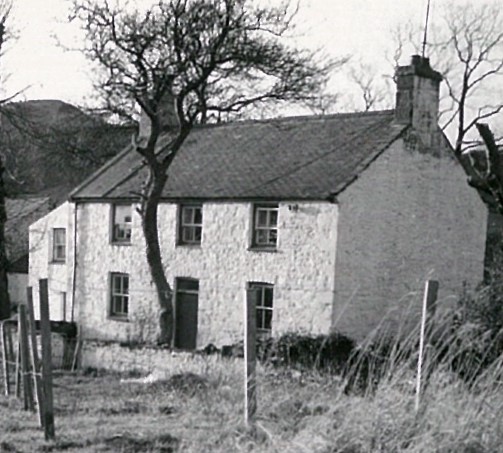
Photo courtesy of Simon Simcox, Bwlch Farm (Deganwy) Ltd.
The sturdy stone exterior of Bwlch farmhouse near Deganwy lends a solidity to the story of Margaret Jones’s madness. What went on in the house during 30 years of remissions and relapses can only be conjectured but the Denbigh case notes may offer some clues.
Margaret was 23 when she first became ill – soon after the birth of her first child Paul Fisher. She was at the time an unmarried domestic servant and it is likely she had been dismissed from her post and sent home to be confined at Bwlch. She recovered after three months and when a daughter was born four years later there were no signs of a recurrence of her insanity.
It was not until 1885 that Margaret’s family noticed that she was low spirited, refusing to eat and neglecting herself. Her married sister Elizabeth Owen, who was by this time living at Bwlch with her husband and children, suspected Margaret was pregnant again and one of the certifying doctors diagnosed puerperal melancholia.
But Margaret’s apparently stuporose condition – “Sits quietly in the same place and is quite passive and insensitive. Takes no notice of anything.”[1]– had nothing to do with pregnancy and she began menstruating again after a few weeks in hospital. These case notes together with the records of her ten subsequent admissions to Denbigh Asylum may offer an alternative explanation for her insanity and provide an insight into the kind of life an unmarried and disgraced young woman might have led in the late 19th century.
Also living at the Bwlch farmhouse with Margaret were her father William Jones and three brothers, Moses, William and Edward. Just before Margaret was discharged from the asylum after her first admission, it is remarked in the case notes that: “This is a case which would certainly be benefited by a change of scene and life”. [2]
Such a cryptic observation might be explained by a closer reading of the earlier notes recording that Margaret was forced to wear tick gloves for several weeks to prevent her scratching her face and disfiguring herself. And by the note referring to a visit from her father in which they “conversed in an undertone”. In all subsequent medical certificates her language is variously described as indecent, obscene, offensive, filthy or foul. It’s not impossible that the suspected pregnancy which prompted her first admission disguised a much darker secret about Margaret’s life at Bwlch.
It remained her home however and, when she was well, Margaret helped her father on the farm and assisted with ‘the usual housework etc’. She also nursed a sick brother and this was suspected to be the cause of another relapse in 1899.
Relations with her sister Elizabeth were strained but it seems Elizabeth bore the brunt of Margaret’s maniacal outbursts when she threatened to hit her with chairs and large stones. Certainly, when ‘Peggy’ – as she had become affectionately known to the asylum staff – was ready to be discharged in August 1903 both Elizabeth and her brother William refused to take her home to Bwlch and she was sent instead to Conway Workhouse. Following another asylum admission the following year she was discharged on trial to her daughter in Rhyl. But the trial failed within a matter of weeks and Margaret spent the last three years of her life in Denbigh where she died in 1907 after a series of epileptiform convulsions.
It was not only Margaret’s regular relapses that the Jones family had to deal with. Her younger sister Jane Jones had become insane in 1897 while living at Bwlch with her husband and children. Jane was admitted to Denbigh with a diagnosis of mania thought to be caused by the loss of a child three weeks earlier and, like her sister, she was to suffer recurrent bouts of insanity and had seven further admissions to the asylum.
The issue of abuse is also obliquely raised in Jane’s case notes. Her claims of ill treatment at the hands of her husband Richard, a joiner by trade, and of his infidelity are lent some credibility by the observation made in 1900 that: “She has no delusions, excepting those concerning her husband, which may not be altogether untrue.”[3] By this time the couple were living in Trefriw and, whatever else might have been lacking in their relationship, it is recorded in 1915 that they had eleven children. Jane’s last admission to Denbigh was in 1925 – “in a nervous and apprehensive state … constant tremors of her face and lips and articulation impaired” [4] – when she was diagnosed with Senile Insanity and discharged home after three months to the care of her daughters.
Footnotes
[1] DRO/HD/1/337/Case no. 452
[2] Ibid.
[3] DRO/HD/1/341/Case no. 5458
[4] DRO/HD/1/356/Case no.10501
